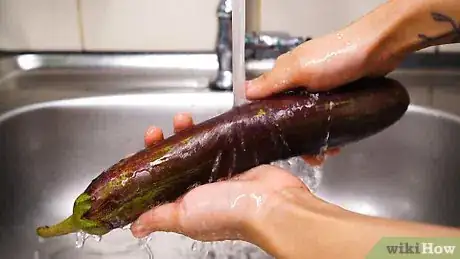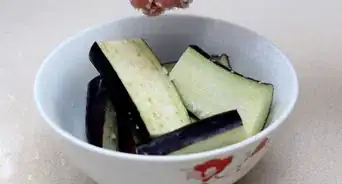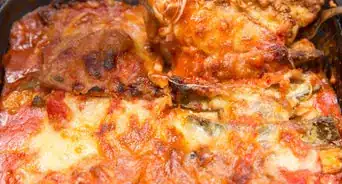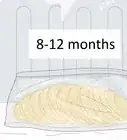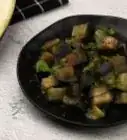This article was co-authored by wikiHow Staff. Our trained team of editors and researchers validate articles for accuracy and comprehensiveness. wikiHow's Content Management Team carefully monitors the work from our editorial staff to ensure that each article is backed by trusted research and meets our high quality standards.
The wikiHow Culinary Team also followed the article's instructions and verified that they work.
This article has been viewed 365,320 times.
Learn more...
Aubergines, known in America as eggplants, come in a wide variety of shapes, sizes and colors. The most popular eggplant is the large purple eggplant. Cooking aubergines is not difficult, though some individuals may shy away from it. There are numerous ways to prepare and cook the aubergine to give you an array of dishes.
Steps
Prepping Aubergine for Cooking
-
1Wash the aubergine thoroughly. Check for brown spots or bruises. If the skin is in good shape, it is edible, though some varieties have skin that is too tough to eat. Peel the skin with a vegetable peeler if you think it’s wise – younger aubergine skin is fine to eat, but older, more ripened aubergine skin has a bitter taste. Cut off the stem and base, too.
- Leave the skin on if you are baking aubergine whole in the oven or roasting it on the grill. It’s also best left on if you want to scrape out the insides later and make an aubergine mash.
-
2Cut the aubergine however your recipe dictates. It could be halved lengthwise, cubed, diced or sliced. It’s sometimes a matter of personal preference, too. Just remember that if you're grilling it, keep it in larger chunks so it doesn't fall through the grates.
- If your recipe calls for mashed or pureed aubergine, do not cut it since you can bake it whole. This is the easiest way, too.
Advertisement -
3Salt the exposed flesh of the aubergine. This helps to draw out the bitterness that an aubergine can typically have. Salting also creates a denser flesh, making it less sponge-like so it will not absorb fat so easily. Keep them sitting in a colander for 20 to 30 minutes.
- If you need, you can skip this step. The aubergine will still be tasty, but it may have a slightly different consistency and be a little more bitter.
-
4Rinse the aubergine under water to remove the salt and thoroughly dry it. This action keeps the aubergine from absorbing too much oil when cooking, keeping the aubergine's crunch.
- Make sure the aubergine is actually dry. Water left on may absorb into the meat of the veggie, making it chewier than is desirable.
Roasting Aubergine
-
1Preheat the oven to 230°C (450°F). You’ll also need to line a baking pan with foil or lightly grease it. Alternatively, if you have one, you can use a Silpat (though a little greasing still wouldn't hurt).
-
2Peel the aubergine, if desired, and cut to size. Consider a few of these variations:
- Cut it into 3/4-inch cubes. Toss the cubes with garlic, olive oil, salt, and black pepper. Once all the cubes are covered, place into the pan.
- Bake your aubergine whole. Pierce the skin a few times when baking so it does not explode from expanding moisture. You can then scoop out the flesh for mashing or pureeing.
- Slice the aubergine length-wise and brush with olive oil and seasoning (diced onion, pepper, grated cheese, breadcrumbs and spices all work wonderfully).
-
3Roast the aubergine about 20 minutes or until tender. If you're working with cubes, you may wish to stir them up about halfway through, or 10 minutes in. And if your oven cooks unevenly, turn the pan around as well. You want each piece to have that hint of crunch while still being tender.
- If you're roasting a whole aubergine, pierce it with a fork. If there is initial pressure and then it slides right in, your aubergine is fully cooked.
Sauteing Aubergine
-
1Heat 2 tablespoons of olive oil in a large pan over medium-high heat. If you don't have olive oil, you can substitute avocado oil, coconut oil, grapeseed oil, or palm oil – and it'll still be healthy.
- Don't be tempted to use much more oil than that; oil will be brushed on the aubergine later. If you bombard the aubergine with even more, it'll take on a fried yet soggy texture.
-
2Slice the aubergine and brush with olive oil on both sides. Slice it in 1/2 inch (1.25 cm) slices, or however your recipe calls for. Sprinkle with salt and pepper to taste. You can also add any other spices you'd like to accompany the aubergine, too.
- If you’d like, coat the aubergine slices in breadcrumbs and Parmesan cheese. You’ll need around ⅓ cup of breadcrumbs and 1 or 2 tablespoons of Parmesan for one, good-sized aubergine. Mix it up and dip each slice in before adding it to the pan.
-
3Add the aubergine slices to the hot oil. Each side will need to cook for about 5 minutes or until golden. Don't walk away from the pan – there's a window of perfection that, if missed, will result in your slices blackening too much. Keep turning as need be for browned perfection.
- Looking for a zestier kick? Add some soy sauce into the mix (but keep some for dipping later). Introduce whatever other flavors you think would pair well, too.
-
4When the slices are evenly browned, take them off the heat. Place them onto a paper towel to sop up the extra oil. Give them a few minutes to cool down and then it's chow time.
- Aubergine is tasty with soy sauce, ranch, or even plain. They're a great complement to any meal, putting a new twist on boring ol' veggies.
Grilling Aubergine
-
1If you’re using a gas grill, preheat it. Put it on medium heat with a grill rack on top. If you’re using a charcoal grill, get the coals going nice and hot.
- Make sure your grill is clean before you use it. Put some vegetable oil on a paper towel and wipe down the grate, one by one. Using oil can also help to prevent sticking.
-
2Peel the aubergine, if desired, and cut into 1/2-inch slices. You can also halve small aubergines lengthwise instead of slicing vertically. Brush slices on all sides generously with olive oil, melted butter, or cooking oil. This adds flavor and keeps them from sticking to the grill rack, too.
- Alternatively, you can grill eggplant whole or sliced in half over a medium to hot flame for 15 to 20 minutes until the skin is blackened. Pierce the skin when cooking aubergines this way to get heat into the center.
-
3Season as desired with herbs, salt, and ground black pepper. You can also brush the aubergine with oil-based marinade instead of the oil or butter. Any marinade that works on other vegetables will work on aubergine, too.
-
4Line the grill with foil or place it directly onto the rack. If you’re working with small slices, lining the grill with foil will be best to keep the slices from falling through the grate. It also keeps the oil on top and redistributable.
- Pierce a few holes into the foil to allow the heat to transfer more quickly.
-
5Grill for about 8 minutes or until crispy and tender, turning occasionally. For both a charcoal and gas grill, place the aubergine on a rack directly above the heat. A gas grill should be covered; a charcoal grill should not.
- When finished, turn off the heat, leave the foil, and transfer the aubergine to a plate. Give both the aubergine and the foil a few minutes to cool down before either are touched.
- The aubergine is now good to be added to a salad or a stir fry, or even eaten alone with your dipping sauce of choice. It can even be kept for later as part of a soup or stew.
Community Q&A
-
QuestionCan I boil aubergine?
 ArthurashfordCommunity AnswerYes. Cut them in small chunks without peeling the skin, and put them in boiling water with salt. Cook them until they are done, 10 minutes or less.
ArthurashfordCommunity AnswerYes. Cut them in small chunks without peeling the skin, and put them in boiling water with salt. Cook them until they are done, 10 minutes or less. -
QuestionWhat shape are aubergines?
 ArthurashfordCommunity AnswerAubergines are grown all around the world in several varieties. The size, color and shape depends on where they are grown.
ArthurashfordCommunity AnswerAubergines are grown all around the world in several varieties. The size, color and shape depends on where they are grown. -
QuestionI sliced and salted aubergine and left them overnight to dry on their cooking tray, made of tin. They turned black! Why was this, and are they still safe to eat?
 Community AnswerAn aubergine will start to discolor as soon as you cut it open, the salt will not prevent that. You should always, regardless of the vegetable, cut and cook straight away. And don't eat them once they've turned black, they will taste horrible.
Community AnswerAn aubergine will start to discolor as soon as you cut it open, the salt will not prevent that. You should always, regardless of the vegetable, cut and cook straight away. And don't eat them once they've turned black, they will taste horrible.
wikiHow Video: How to Cook Aubergine
Warnings
- White eggplants are notorious for tough skin; always peel this type of eggplant.⧼thumbs_response⧽
Things You'll Need
- Salt and pepper, to taste
- Colander
- Paper Towels
- Oil (preferably olive)
- Knife
- Seasonings
- Aluminium foil
- Tongs (optional)
- Baking pan (if baking)
References
About This Article
Before cooking aubergine, wash it thoroughly and cut it lengthwise, in cubes, or in slices. After you cut the aubergine, season it with salt and then rinse it under water to draw out any bitter flavor. Then, before roasting your aubergine, preheat the oven to 450 degrees Fahrenheit and place the food on a lightly oiled baking pan. Season it with some olive oil, onion, pepper, grated cheese, or breadcrumbs on top, then cook for 20 minutes or until tender. To learn how to grill aubergine, keep reading!
